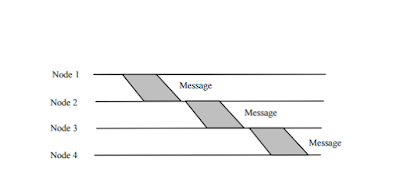explain packet switching and circuit switching
Message Switching
In this switching method, a different strategy is used, where instead of establishing a
dedicated physical line between the sender and the receiver, the message is sent to the
nearest directly connected switching node. This node stores the message, checks for
errors, selects the best available route and forwards the message to the next intermediate
node.
 |
| Message Switching Technique |
The line becomes free again for other messages, while the process is being
continued in some other nodes. Due to the mode of action, this method is also known as
store-and-forward technology where the message hops from node to node to its final
destination. Each node stores the full message, checks for errors and forwards it.
In this switching technique, more devices can share the network bandwidth, as
compared with circuit switching technique. Temporary storage of message reduces traffic
congestion to some extent. Higher priority can be given to urgent messages, so that the
low priority messages are delayed while the urgent ones are forwarded faster. Through
broadcast addresses one message can be sent to several users. Last of all, since the
destination host need not be active when the message is sent, message switching
techniques improve global communications.
However, since the message blocks may be quite large in size, considerable
amount of storage space is required at each node to buffer the messages. A message
might occupy the buffers for minutes, thus blocking the internodal traffic.
Basic idea:
• Each network node receives and stores the message
• Determines the next leg of the route, and
• Queues the message to go out on that link.
Advantages:
• Line efficiency is greater (sharing of links).
• Data rate conversion is possible.
• Even under heavy traffic, packets are accepted, possibly with a greater delay in
delivery.
• Message priorities can be used, to satisfy the requirements, if any.
Disadvantages: Message of large size monopolizes the link and storage
Packet Switching
The basic approach is not much different from message switching. It is also based on the
same ‘store-and-forward’ approach. However, to overcome the limitations of message
switching, messages are divided into subsets of equal length called packets. This
approach was developed for long-distance data communication (1970) and it has evolved
over time. In packet switching approach, data are transmitted in short packets (few
Kbytes). A long message is broken up into a series of packets as shown in Fig.Every packet contains some control information in its header, which is required for
routing and other purposes.
 |
| A message is divided into a number of equal length short packets |
Main difference between Packet switching and Circuit Switching is that the
communication lines are not dedicated to passing messages from the source to the
destination. In Packet Switching, different messages (and even different packets) can pass
through different routes, and when there is a "dead time" in the communication between
the source and the destination, the lines can be used by other sources.
There are two basic approaches commonly used to packet Switching: virtualcircuit
packet switching and datagram packet switching. In virtual-circuit packet
switching a virtual circuit is made before actual data is transmitted, but it is different from
circuit switching in a sense that in circuit switching the call accept signal comes only
from the final destination to the source while in case of virtual-packet switching this call
accept signal is transmitted between each adjacent intermediate node as shown in Fig.
4.2.3. Other features of virtual circuit packet switching are discussed in the following
subsection.
Virtual Circuit Packet Switching Networks
An initial setup phase is used to set up a route between the intermediate nodes for all the
packets passed during the session between the two end nodes. In each intermediate node,
an entry is registered in a table to indicate the route for the connection that has been set
up. Thus, packets passed through this route, can have short headers, containing only a
virtual circuit identifier (VCI), and not their destination. Each intermediate node passes
the packets according to the information that was stored in it, in the setup phase. In this
way, packets arrive at the destination in the correct sequence, and it is guaranteed that
essentially there will not be errors. This approach is slower than Circuit Switching, since
different virtual circuits may compete over the same resources, and an initial setup phase
is needed to initiate the circuit. As in Circuit Switching, if an intermediate node fails, all
virtual circuits that pass through it are lost. The most common forms of Virtual Circuit
networks are X.25 and Frame Relay, which are commonly used for public data networks
(PDN).
 |
| Virtual circuit packet switching technique |
Datagram Packet Switching
Networks
This approach uses a different, more dynamic scheme, to determine the route through the
network links. Each packet is treated as an independent entity, and its header contains full
information about the destination of the packet. The intermediate nodes examine the
header of the packet, and decide to which node to send the packet so that it will reach its
destination. In the decision two factors are taken into account:
• The shortest ways to pass the packet to its destination - protocols such as
RIP/OSPF are used to determine the shortest path to the destination.
• Finding a free node to pass the packet to - in this way, bottlenecks are eliminated,
since packets can reach the destination in alternate routes.
Thus, in this method, the packets don't follow a pre-established route, and the
intermediate nodes (the routers) don't have pre-defined knowledge of the routes that
the packets should be passed through.
 |
| Datagram Packet switching |
Packets can follow different routes to the destination, and delivery is not
guaranteed (although packets usually do follow the same route, and are reliably sent).
Due to the nature of this method, the packets can reach the destination in a different order
than they were sent, thus they must be sorted at the destination to form the original
message. This approach is time consuming since every router has to decide where to send
each packet. The main implementation of Datagram Switching network is the Internet,
which uses the IP network protocol.
Advantages:
• Call setup phase is avoided (for transmission of a few packets, datagram will be
faster).
• Because it is more primitive, it is more flexible.
• Congestion/failed link can be avoided (more reliable).
Problems:
• Packets may be delivered out of order.
• If a node crashes momentarily, all of its queued packets are lost.
People also ask by GOOGLE
Virtual Circuit Versus Datagram Packet Switching
Key features of the virtual circuit packet switching approach is as follows:
• Node need not decide route
• More difficult to adopt to congestion
• Maintains sequence order
• All packets are sent through the same predetermined route
On the other hand, the key features of the datagram packet switching are as follows:
• Each packet is treated independently
• Call set up phase is avoided
• Inherently more flexible and reliable


Post a Comment
have you a any doubt then tell and if you want some topic then please tell .